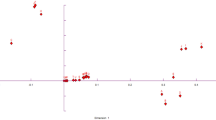Abstract
The Hani is a local minority in the southwestern part of China. To establish a database of ethnic short tandem repeats (STRs), 17 autosomal STRs in the Hani ethnic group were investigated. A total of 706 unrelated individuals from three Hani settlements were genotyped using the PowerPlex® 18D System. Allele frequency data and forensic parameters were evaluated. The genetic relationship among the Hani and 11 related populations was assessed.
Similar content being viewed by others
References
Butler JM (ed) (2005) Forensic DNA typing: biology, technology, and genetics of STR markers, 2nd ed. Elsevier Academic Press, New York
Lewis P (2009) Ethnologue: languages of the world, 16th ed. SIL International, Dallas
Tereba A (1999) Tools for analysis of population statistics. Profiles in DNA:14-16
Excoffier L, Lischer HE (2010) Arlequin suite ver 3.5: a new series of programs to perform population genetics analyses under Linux and Windows. Mol Ecol Resour 10(3):564–567. doi:10.1111/j.1755-0998.2010.02847.x
Tamura K, Dudley J, Nei M, Kumar S (2007) MEGA4: Molecular Evolutionary Genetics Analysis (MEGA) software version 4.0. Mol Biol Evol 24(8):1596–1599. doi:10.1093/molbev/msm092
Weir BS (1996) Genetic data analysis II. Sinauer Associates, Sunderland, Massachusetts
Poetsch M, Bajanowski T, Pfeiffer H (2012) The publication of population genetic data in the International Journal of Legal Medicine: guidelines. Int J Legal Med 126(4):489–490. doi:10.1007/s00414-012-0700-z
Acknowledgments
We are deeply thankful for all donors who contributed their DNA sample to this study. This work was supported by the grants from the Natural Science Foundation of China (81260467) and the Science and Technology Planning Projects of Yunnan Province (2011CA022, 2011FZ113)
Author information
Authors and Affiliations
Corresponding author
Additional information
Ying Huang and Jinyong Yao contributed equally to this work.
Electronic supplementary material
Below is the link to the electronic supplementary material.
Figure S1
The geographic location and topographic map of the Hani from the southwestern part of mainland China. The unrelated Hani samples were collected from three Hani settlements including Honghe (a), Puer (b) and Yuxi (c) in southwestern mainland China. (DOC 263 kb)
Figure S2
NJ-Phylogenetic tree based on the Nei’s genetic distance. (DOC 25 kb)
Table S1
(XLSX 13 kb)
Table S2
(XLSX 11 kb)
Table S3
(XLSX 10 kb)
Rights and permissions
About this article
Cite this article
Huang, Y., Yao, J., Li, J. et al. Population genetic data for 17 autosomal STR markers in the Hani population from China. Int J Legal Med 129, 995–996 (2015). https://doi.org/10.1007/s00414-015-1176-4
Received:
Accepted:
Published:
Issue Date:
DOI: https://doi.org/10.1007/s00414-015-1176-4




